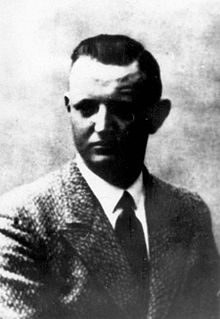Ludwig Hahn
This article needs additional citations for verification. (August 2023) |
Ludwig Hahn | |
|---|---|
 | |
| Born | 23 January 1908 Eitzen, Province of Hanover, German Empire |
| Died | 10 November 1986 (aged 78) Ammersbek, West Germany |
| Allegiance | |
| Service/ | |
| Years of service | 1933–1945 |
| Rank | SS-Standartenführer |
| Unit | Reich Security Main Office (RSHA) |
| Commands held |
|
| Battles/wars |
|
| Relations | Johannes Steinhoff (brother-in-law) |
Ludwig Hermann Karl Hahn (23 January 1908 – 10 November 1986) was a
As a senior officer of the Sicherheitspolizei (Security Police) and Sicherheitsdienst (Security Service) in occupied-Poland, Hahn was directly involved in the liquidation of the Warsaw Ghetto (July–September 1942) and the brutal suppression of both the Warsaw Ghetto Uprising (April–May 1943) and the Warsaw Uprising (August–October 1944).
During postwar investigations against him, Hahn was imprisoned from July 1960 to July 1961 and December 1965 to December 1967. Between 1972 and 1975, Hahn was the subject of two separate
Biography
The son of a prosperous farmer of the same name, Hahn was born on 23 January 1908, in the rural town of
After successfully defending his

Early Nazi career
In December 1933 Hahn was attached to the
Hahn began his career with the
During the build-up to
World War II
During the
Following the dissolution of Einsatzgruppe I, Hahn served as Stadtkommissar (City Commissioner) for the city of Przemyśl (Prömsel) from November–December 1939. Hahn next took over as Commander of the Sicherheitspolizei (SiPo) and the Sicherheitsdienst (SD) for the occupied city of Kraków in January 1940. He also served as chief of the "Police Emergency Court" (Standgericht) at Montelupich Prison. In this capacity Hahn was instrumental in the implementation of the German AB-Aktion in Poland.
In August 1940, Hahn was transferred to
Warsaw
In August 1941, Hahn returned to occupied-Poland and was appointed Commander of the Sicherheitspolizei (SiPo) and the Sicherheitsdienst (SD) for the city of Warsaw. His headquarters was housed in the former offices of the Ministry of Religious Affairs and Public Education. As Commander of the SiPo and the SD, Hahn would oversee a force of approximately 2,000 individuals; including a staff of 500-600 SS security personnel, as well as around 1,000 Polish police auxiliaries and several guard companies composed mostly of Ukrainian and Cossack collaborators.
During his tenure, Hahn was directly involved in the planning and implementation of the
As a deputy officer to
During the August–October 1944
Later service with the SS
In November 1944, Hahn departed Warsaw and returned to
Hahn was next appointed Commander of the SiPo and the SD for the city of
Postwar life
Hahn remained in Germany after 1945 and went into hiding in
Afterward, Hahn would go on to pursue a successful postwar career as an insurance broker in West Germany. In 1951 his father-in-law arranged for him to take a position as Deputy Director for Organizational Matters with the Hanover branch of Karlsruher Lebensversicherung A.G. He rose to the office of Branch Manager in 1955. Hahn and his family relocated to Hamburg in 1958 where he had been hired as head of the life insurance division of Hans Rudolf Schmidt & Co. GmbH. The family settled in a comfortable home in the borough of Bahrenfeld.
Trials and convictions

Hahn's identity was uncovered by journalists in 1960. Following an inquiry by the Central Office of the State Justice Administrations for the Investigation of National Socialist Crimes, Hahn was arrested by the West German federal police for his suspected involvement in the destruction of the Warsaw Ghetto. He was held by West German investigators for a year, however no charges were brought against him due to insufficient evidence and he was released in July 1961. Hahn was arrested a second time in December 1965 and held in pre-trial detention for two years, but was ultimately released again, owing to his poor health. After his release, Hahn briefly worked for the Hamburg branch of Investors Overseas Service. He retired in 1967.
It was not until May 1972 that Hahn was successfully charged with war crimes by the
During the appeals process, Hahn was also on trial in a different
Summary of SS career
Dates of rank
- SS-Standartenführer, Regierungs- und Kriminaldirektor, Oberst der Polizei (April 20, 1944)
- SS-Obersturmbannführer (November 9, 1941)
- Oberregierungs- und Kriminalrat (September 12, 1941)
- SS-Sturmbannführer, Regierungs und Kriminalrat (September 26, 1938)
- SS-Hauptsturmführer und Kriminalrat (August 1, 1938)
- SS-Obersturmführer und Kriminalkommissar (January 30, 1938)
- SS-Untersturmführer (April 20, 1936)
- SS-Hauptscharführer (November 9, 1935)
- SS-Unterscharführer (June 1, 1935)
- SS-Rottenführer (November 9, 1934)
- SA-Scharführer (December 1930)
Awards and decorations
- Iron Cross, First Class (October 9, 1944)
- War Merit Cross with Swords (January 30, 1943)
- Iron Cross, Second Class (July 6, 1940)
- Ehrendegen der Reichsfuhrer-SS
- Totenkopfring der SS
- Honor Chevron for the Old Guard
References
- ^ a b c Josef Wulf, Das Dritte Reich und seine Vollstrecker – Die Liquidation von 500.000 Juden im Ghetto Warschau, Berlin 1961, p. 290
- ^ Jacek Andrzej Młynarczyk, "Vom Massenmörder zum Lebensversicherer. Dr. Ludwig Hahn und die Mühlen der deutschen Justiz", Andrej Angrick, Klaus-Michael Mallmann (eds.), Die Gestapo nach 1945. Karrieren, Konflikte, Konstruktionen, Darmstadt 2009, p. 136
- ^ Dan Kurzman, The Bravest Battle: The Twenty-eight Days Of The Warsaw Ghetto Uprising, Da Capo Press, 2009, p. 346
External links
 Media related to Ludwig Hahn at Wikimedia Commons
Media related to Ludwig Hahn at Wikimedia Commons- "Bis zum letzten". Der Spiegel (in German). No. 1. 1973. Retrieved 29 January 2015.
